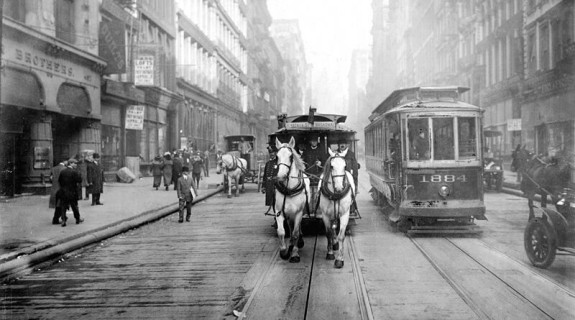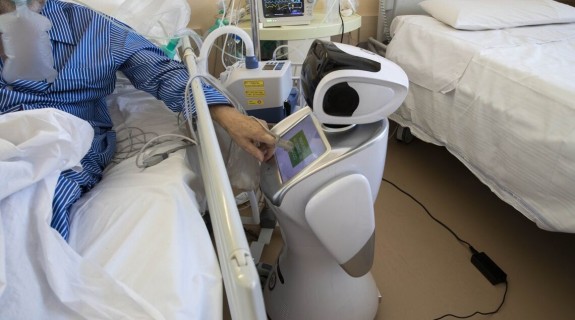Automation Nation: The Future of Work in Greater Philadelphia
Automation Nation
By: Mike Shields & Mohona Siddique
From robot supermarket assistants to smartphones, from the Zoom conference room to Siri, once far-off science fiction technologies are now regular occurrences in our daily lives and working worlds. But the rapid spread of these technologies it is not without risk; today’s advances sit at the intersection of competing dynamics. Present-day conversations about racial equity, the COVID-19 pandemic’s impact on workers, and the changing nature of work each provide an important lens into technological progress and its consequences. And perhaps more importantly, each raises questions about technology, its intersection with work and equity: who has access, who benefits, and who potentially gets left behind?
To provide context and data to inform ongoing conversations about the future of work, the Economy League of Greater Philadelphia presents this new Leading Indicators series, Automation Nation. This series examines the risk of automation within various sectors of the regional economy to contribute to ongoing conversations about building an equitable future for all of Greater Philadelphia’s workers.

Job Automation Isn’t New for Humans (or Horses)
Job automation is of course not new to the twenty-first century. At its core, capitalism is about seeking more efficient methods of production through new technologies that reduce costs and streamline labor. There are countless examples throughout global economic history of new technologies displacing physical labor. The introduction of the mechanical printing press in the mid-1400s diminished the need for human copywriters. The introduction of the steam locomotive and “the horseless carriage” (or automobile) in the late nineteenth century displaced work horses that would cart humans and supplies. In the twentieth century, the mechanized assembly line diminished the need for both artisanal skill and physical strength in manufacturing. The combination of profit motive and human ingenuity drives a near-perpetual cycle of job automation. Throughout history, however, automation has generally been applied to relatively routine work, and humans have then developed new lines of work that require our unique cognitive abilities and emotional intelligence.
There are many who contend that the dramatic advances in computing power, machine learning, and artificial intelligence will upend that historical pattern. Many of the new technologies in the past few decades simulate cognitive abilities. Advances in machine learning and artificial intelligence evoke images of robots and self-driving cars replacing the entirety of the human workforce. At present, though, most of these technologies still lag their human counterparts in terms of cognition. Thus, there is greater opportunity to preemptively think of policies, practices, and workforce development strategies that can ease the burden of today’s job automation. Some example strategies and discussions from field experts are listed below:

Task Automation over Job Automation
The phrase “job automation” should really be thought of as “task automation.” Automation uses technology to make routine daily tasks more efficient. The adoption of an electronic calendar, for example, is a form of automation. By exchanging a perishable paper calendar with scribbled reminders for an online calendar and its electronic reminders, the task of scheduling and remembering important dates is automated. The more routinized the task, the higher its susceptibility to automation. Thus, occupations with more routine and less variability in their daily workflows generally face a greater risk of automation. A simple example is the automation of the retail checkout experience with self-checkout machines. Fifty years ago, human cashiers read price labels and punched them into cash registers; thirty-five years ago humans ran bar-coded items across optical scanners and bagged them for customers; today, the customer interacts directly with the scanner and the machine has replaced the human cashier’s primary routinized tasks.
Few occupations will be unaffected by automation in the coming century since our daily work lives often require us to interact with some form of technology such as a computer, cell phone, or machinery. A major consequence of task automation, however, is that it reduces the need for human employees in foundational skill-level jobs. These entry level jobs are often the only option for younger workers just starting in the workforce, those with minimal education, and new immigrants. As automation continues to reduce foundational skill-level occupations, more entry-level workers could be left without employment opportunities.

The COVID-19 Pandemic and Job Automation
The onset of the COVID-19 pandemic and its economic lockdown seem to have fast-tracked automation efforts across industries. With the loss of 40 million jobs across the country between March and April 2020, the pandemic incentivized business owners to consider investing more in new technologies that reduce person-to-person contact. Technologies like floor-cleaning robots, touchscreen ordering, self-checkout machines, remote sensor toll booths, and electronic information kiosks both reduce the risk of spreading disease and cut labor costs. Many of these technologies will displace cashiers, toll booth attendants, front-desk clerks, serving staff, and other foundational skill-level jobs that many workers rely on for their income. As the pandemic continues, more businesses may consider adopting new technologies in the name of safety - which may leave many of these foundational skill-level workers unemployed for some time.
Part 1: Automation and Greater Philadelphia's Food Economy
For the first installment of the Automation Nation series, we take a closer look at the automation potential within Greater Philadelphia’s food economy. The Economy League has deep expertise about the regional food economy including, its growth and the impact of the pandemic on its future. As discussed in the 2019 Good Eats report, Greater Philadelphia’s food-based businesses fuel extensive commercial activity and create thousands of jobs in the region. Yet many of these jobs offer minimal pay and few sustainable career trajectories. Since many occupations within the food economy are also characterized by a high number of routinized daily tasks that are susceptible to automation, the sector may act as a benchmark for comparison among other regional industries.
Part 2: Automation in Greater Philadelphia's Healthcare and Social Assistance Industry
In the second installment of our Automation Nation series, we dive deeper into automation trends in the U.S. healthcare and social assistance industry and discuss the potential impact in our region. As we previously noted, Greater Philadelphia’s healthcare and social assistance industry has long been a vital economic asset in terms of regional employment and services. The COVID-19 pandemic and the resurgent movement for racial equity have only amplified the critical role of this sector. What has gotten less attention, however, is that automation has proceeded apace in healthcare and social assistance industry, which may lead to significant changes in the nature of work and the composition of the industry’s workforce.
Part 3: Automation in Greater Philadelphia's Transportation Industry
A fully-functioning, multimodal transportation network of roads, rails, waterways, and air travel is essential for efficiently moving goods and workers through and from a metropolitan region. The workers who build, maintain, and support that network are vital since their daily tasks keep the region moving and growing. Automation trends in the transportation industry are already supplanting the daily tasks of this essential workforce and may leave thousands of employees with limited prospects. In the third installment of our Automation Nation series, we take a look at the automation potential in Greater Philadelphia’s transportation sector.